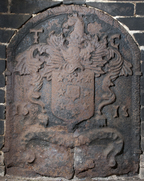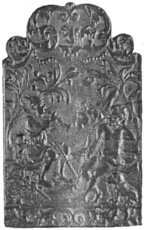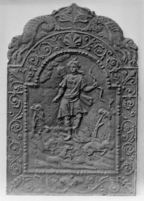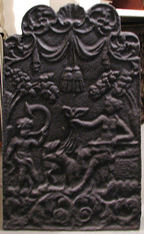-
1077
Description: Canted rectangle; astragal edging (top and sides); symmetrically arranged, initials separated by overpressed, fillet edged stamp bearing letters WF surmounted by a bent arm holding a battleaxe issuing from a chapeau; beneath are two shields bearing the arms of Fowle.
Notes: The shield and crest stamps relate to William Fowle (1568-1634) and are those used on iron grave slabs in Wadhurst and Frant churches and in Maidstone museum, as well as on other firebacks. The initials have not been identified. Another casting with the same set of initials, but in a slightly different arrangement, has been noted (no. 68), and Christy (1908 p.386) reported on another with slots for two firedogs.
Inscription: EC DT / WF
Arms: William Fowle, of Frant and Wadhurst
- Decoration tags:
- rectangular with canted top corners (shape)
- astragal (edging)
- carved stamps
- individual letters
- heraldic
- armorial
- text
Manufactured: in the early- to mid-17th century probably at Riverhall Furnace, Wadhurst in the Weald area of England.
Current location: in private hands, Minster-on-Sea, Kent, England.
- Attached to series:
- Fowle series
-
1169
Description: Rectangular shape; cyma reversa moulded edging (top and sides); top centre, initials EHA in triad; date split each side of initials.
Notes: Well formed and well spaced letters and numbers.
Inscription: 17 EHA [triad] 51
- Decoration tags:
- rectangular (shape)
- cyma reversa/ogee (edging)
- individual letters
- individual numbers
- text
Manufactured: in 1751 in England.
Current location: not known.
- Attached to series:
- Date & initials firebacks
-
1296
Description: Low arched rectangular shape; broad rebated fillet edging; stylised Tudor royal shield, crown and supporters (dragon and greyhound); Tudor rose in top left corner; portcullis in top right corner.
Notes: Pastiche 'Tudor' design by George Shaw of Saddleworth, Lancashire, c.1850, possibly intended to be passed off as genuine Tudor. Another casting is at Hever Castle, Kent. Firebacks with the same armorial design within a different, arched edging are also known. Copies of this fireback were advertised in Bratt Colbran Ltd.'s (London) catalogue in the early-20th century.
Copies of this fireback are known.
Arms: Tudor royal
- Decoration tags:
- rectangular with round arch (shape)
- fillet (edging)
- carved pattern panels
- heraldic
- armorial
- royal
Manufactured: in the mid-19th century possibly in the Lancashire area of England.
Current location: Mottistone Manor, Brighstone, Isle of Wight, England.
Museum number: NT/MOE/M/2 (part of the National Trust museum group)
- Attached to series:
- George Shaw series
- Tudor royal armorial firebacks
-
954
Description: Arched shape; patterned astragal edging; central shield with helm, crest and mantling above, and motto scroll below; initials either side of crest; date split by shield.
Notes: The arms are those of Chamberlayne: gules, an inescutcheon within an orle of mullets argent; the crest: out of a ducal coronet the head of an ass (the tinctures vary according to the branch of the family); the initials are reputed to be those of Thomas Chamberlayne; the date appears to have been hand inscribed. The style of the carving is the same as on two other firebacks in the same county.
Inscription: T C / 16 18 / [motto unreadable]
Arms: Chamberlayne
- Decoration tags:
- rounded arched (shape)
- astragal (edging)
- whole carved pattern
- individual letters
- individual numbers
- armorial
- text
Manufactured: in 1618 possibly in the Herefordshire area of England.
Current location: Hellens Manor, Much Marcle, Herefordshire, England.
- Attached to series:
- Personal armorial firebacks
- Herefordshire armorial series
-
1290
Description: Rectangular, with arch at the top. Above and below acanthus vines. In the middle a landscape with trees and two seated figures; on the left Mercury, playing a flute, a staff over his right shoulder, and at his feet a caduceus; to the right a seated male figure with his left hand supporting his head, in his right hand a stick with which he is supporting himself, behind him a cow, at his feet a dog.
Notes: A scene from classical mythology.
- Decoration tags:
- rectangular with ornate arch (shape)
- fillet (edging)
- whole carved pattern
- pictorial
- mythological
- animals
- humans
- plants
- objects
Manufactured: in the early-18th century in England.
Current location: Rotterdam, Netherlands.
Museum number: 15229 (part of the Museum Rotterdam museum group)
- Attached to series:
- Late pictorial series 2
- Late pictorial series (all)
-
53
Description: Arched rectangular shaped central panel, bead on fillet edging, narrow-necked urn with flowers issuing therefrom; arched rectangular shaped border with fillet edging and symmetrical floral swags; on top, stylised fish with floral accessories; at bottom, two looped 'W' figures between split date in bottom corners. A faint plankline, slightly inclined from the vertical and more evident on a later casting, can be seen slightly left of centre.
Notes: The second smallest of six flower vase designs in this series. All incorporate the looped 'W' motif which may be intended to identify the pattern maker. A clear vertical plankline left of centre.
Copies of this fireback are known.
Inscription: 17 24
- Decoration tags:
- 'Dutch' (shape)
- fillet (edging)
- whole carved pattern
- planklines
- pictorial
- text
- plants
- objects
Manufactured: in 1724 in England.
Current location: Thornhill Galleries, 43-45 Wellington Crescent, New Malden, Surrey, England.
- Attached to series:
- 1724 series
- British 'Dutch' style firebacks
-
1211
Description: Arched rectangular shape: ovolo-moulded edging; pictorial scene of St George in armour, mounted on a horse, spearing a dragon which lies beneath the horse; in each top corner, a rose.
Notes: A portrayal of St George and the Dragon in bold relief that owes something to the famous modelling by Benedetto Pistrucci of 1817; however, the figure of St George is disproportionately large in relation to the horse.
- Decoration tags:
- rectangular with round arch (shape)
- ovolo (edging)
- whole carved pattern
- pictorial
- mythological
- animals
- humans
- plants
Manufactured: in the 20th century in England.
Current location: Thornhill Galleries, 43-45 Wellington Crescent, New Malden, London, England.
- Attached to series:
- Miscellaneous pattern firebacks
-
866
Description: Rectangular with a sinuous arch and three simulated loops, one top centre, the other two to each side; two-handled flower vase with gadrooned upper surface and acanthus bas-relief below, trailing fruited vines issuing from top descending through handles to base; lion’s mask at top; date split either side of vase base; ball on each shoulder of the plate; broadened side edges.
Notes: The simulated loops are seen on a small number of other firebacks, suggesting a common pattern-maker; a variation on a design typical of this period.
Inscription: 16 77
- Decoration tags:
- rectangular with ornate arch (shape)
- fillet (edging)
- whole carved pattern
- individual numbers
- extension panels
- pictorial
- text
- plants
- objects
Manufactured: in 1677 possibly in the Weald area of England.
Current location: Metropolitan Museum of Art, 1000, Fifth Avenue, New York, New York, United States of America.
Museum number: 08.81.1 (part of the Metropolitan Museum of Art, New York museum group)
- Attached to series:
- Gadrooned vase firebacks
- Loop edged firebacks
-
867
Description: Arched rectangular central panel; bead-and-pellet edging; pictorial scene of a male figure, standing on a ground with trees and animals, with a quiver of arrows and holding a bow in his left hand; clouds above; arched rectangular border with fillet edging; repeated, linked scroll-work on all sides; on top symmetrical leaves between two mirrored serpents.
Notes: The figure is probably that of Apollo.
- Decoration tags:
- 'Dutch' (shape)
- fillet (edging)
- whole carved pattern
- mythological
- animals
- humans
- plants
Manufactured: in the early-18th century in England.
Current location: Metropolitan Museum of Art, 1000, Fifth Avenue, New York, New York, United States of America.
Museum number: 08.81.2 (part of the Metropolitan Museum of Art, New York museum group)
- Attached to series:
- British 'Dutch' style firebacks
-
868
Description: Rectangular with arched, mirrored scrolls on top and central scallop shell, below which are swagged drapes with a central tassel; fillet edging; in a grove, to the left a putto blowing a horn, to the right a semi-naked female figure seated, holding the tail of a fish, with two ?dogs at her feet; at the bottom, narrow panel with symmetrical scrolled foliate decoration.
Notes: Like others in the series, the scene is not immediately identifiable with a scene in classical mythology.
Copies of this fireback are known.
- Decoration tags:
- rectangular with ornate arch (shape)
- fillet (edging)
- whole carved pattern
- pictorial
- mythological
- animals
- humans
- plants
Manufactured: in the early-18th century in England.
Current location: Metropolitan Museum of Art, 1000, Fifth Avenue, New York, New York, United States of America.
Museum number: 08.81.6 (part of the Metropolitan Museum of Art, New York museum group)
- Attached to series:
- Late pictorial series (all)
- Late pictorial series 2









